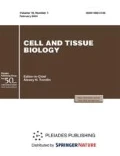Abstract
Liver cancer is an aggressive and heterogeneous human tumor. Lithium compounds block proliferation and induce apoptosis of hepatocarcinoma cells, but cannot cause the death of an entire population of tumor cells. The aim of this study was to reveal morphological types of target cells for different lithium preparations on the basis of their action on hepatocarcinoma-29 cells. The viability of hepatocarcinoma-29 cells was assessed by the MTT test. A dose-dependent decrease in viability was revealed upon addition of native and nanosized lithium carbonate and citrate. Target cells for lithium salts were revealed based on the morphological criteria for five differentiation stages of hepatocarcinoma-29 cells. It was shown that hepatocarcinoma- 29 proliferating cells of differentiation stages I and II are the target cells for native and nanosized lithium citrate, while differentiated cells of differentiation stages III and IV are the target cells for nanosized lithium carbonate. It was revealed that hepatocarcinoma-29 cells are more sensitive to nanosized lithium salts rather than to their native forms. This makes it possible to affect tumor growth more effectively.
Similar content being viewed by others
Abbreviations
- HC-29:
-
hepatocarcinoma-29
- GSK 3β:
-
glycogen synthetase kinase 3β
References
Alizadeh, A.A, Aranda, V., Bardelli, A., Blanpain, C., Bock, C., Borowski, C., Caldas, C., Califano, A., Doherty, M., Elsner, M., Esteller, M., Fitzgerald, R., Korbel, J.O., Lichter, P., Mason, C.E., Navin, N., Pe’er, D., Polyak, K., Roberts, C.W., Siu, L., Snyder, A., Stower, H., Swanton, C., Verhaak, R.G., Zenklusen, J.C., Zuber, J., and Zucman-Rossi, J., Toward understanding and exploiting tumor heterogeneity, Nat. Med., 2015, vol. 21, pp. 846–853.
Bgatova, N.P., Borodin, Yu.I., Makarova, V.V., Pozhidaeva, A.A., Rachkovskaya, L.N., and Konenkov, V.I., Effects of nanosized lithium carbonate particles on intact muscle tissue and tumor growth, Bull. Exp. Biol. Med., 2014, vol. 157, no. 1, pp. 102–108.
Bgatova, N.P., Omeliyanchuk, L.V., Pozhidaeva, A.A., Semeshin, V.F., Lykov, A.P., Poveschenko, O.V., Makarova, O.P., Rachkovskaya, L.N., Borodin, Yu.I., and Konenkov, V.I., Morphological criteria stages of cell differentiation experimental hepatocarcinoma for evaluating anticancer agents, Bull. Exp. Biol. Med., 2015, vol. 160, no. 7, pp. 126–132.
Cassidy, J.W., Caldas, C., and Bruna, A., Maintaining tumor heterogeneity in patient-derived tumor xenografts, Cancer Res., 2015, vol. 75, pp. 2963–2968.
Freland, L. and Beaulieu, J.M., Inhibition of GSK-3β by lithium, from single molecules to signaling networks, Front. Mol. Neurosci., 2012, vol. 5, pp. 14–21.
Greenblatt, D.Yu., Ndiaye, M., Chen, H., and Kunnimalaiyaan, M., Lithium inhibits carcinoid cell growth in vitro, Am. J. Transl. Res., 2010, vol. 2, pp. 248–253.
Hossein, G., Zavareh, V.A., and Fard, P.S., Combined treatment of androgen-independent prostate cancer cell line DU145 with chemotherapeutic agents and lithium chloride: effect on growth arrest and/or apoptosis, Avicenna J. Med. Biotechnol., 2012, vol. 4, pp. 75–87.
Isupov, V.P., Eremina, N.V., and Bulina, N.V., Mechanical activation of lithium carbonate, Izv. Tomsk. Polytekh. Univ., 2013, vol. 322, no. 3, pp. 29–31.
Kaledin, V.I., Zhukova, N.A., Nikolin, V.P., Popova, N.A., Belyaev, M.D., Baginskaya, N.V., Litvinova, E.A., Tolstikova, T.G., Lushnikova, E.L., and Semenov, D.E., Hepatocellular carcinoma-29-metastatic transplantable tumor of mice, causing cachexia, Bull Exp Biol Med., 2009, vol. 148, no. 12, pp. 664–669.
Khan, I.N., Al-Karim, S., Bora, R.S., Chaudhary, A.G., and Saini, K.S., Cancer stem cells: a challenging paradigm for designing targeted drug therapies, Drug Discov. Today, 2015, vol. 20, pp. 1205–1216.
Li, H., Huang, K., Liu, X., Liu, J., Lu, X., Tao, K., Wang, G., and Wang, J., Lithium chloride suppresses colorectal cancer cell survival and proliferation through ROS/GSK-3β/NF-κβ signaling pathway, Oxid. Med. Cell Longev., 2014.doi 10.1155/2014/241864
Li, L. and Wang, H., Heterogeneity of liver cancer and personalized therapy, Cancer Lett., 2015.doi 10.1016/j.canlet. 2015.07.018
Lim, B., Allen, J.E., Prabhu, V.V., Ma, S., Chan, K.W., and Guan, X.-Y., In search of liver cancer stem cells, Stem Cell Rev., 2008, vol. 4, pp. 179–192.
Lim, B., Allen, J.E., Prabhu, V.V., Talekar, M.K., Finnberg, N.K., and El-Deiry, W.S., Targeting TRAIL in the treatment of cancer: new developments, Expert. Opin. Ther. Targets, 2015, vol. 19, pp. 1171–1185.
O’Donovan, T.R., Rajendran, S., O’Reilly, S., O’Sullivan, G.C., and McKenna, S.L., Lithium modulates autophagy in esophageal and colorectal cancer cells and enhances the efficacy of therapeutic agents in vitro and in vivo, PLoS One, 2010.doi 10.1371/journal.pone.0134676
Sylvester, P.W., Optimization of the tetrazolium dye (MTT) colorimetric assay for cellular growth and viability, Methods Mol. Biol., 2011, vol. 716, pp. 157–168.
Tee, J.K., Ong, C.N., Bay, B.H., Ho, H.K., and Leong, D.T., Oxidative stress by inorganic nanoparticles, Wiley Interdiscip. Rev. Nanomed. Nanobiotechnol., 2015.doi 10.1002/wnan.1374
Tsynkalovskiy, O.R., Zaydenov, V.A., Pakhotnykh, A.S., and Andrianov, V.A., The use of “side population” for release of stem cells in normal and tumor tissues, Med. Immunol., 2008, vol. 10, nos. 4–5, pp. 319–326.
Zhou, W., Xu, X., Gao, J., Sun, P., Li, L., Shi, X., and Li, J., TCM matrine induces cell arrest and apoptosis with recovery expression of the hepato-specific miR122a in human hepatocellular carcinoma Hep G2 cell line, Int. J. Clin. Exp. Med., 2015, vol. 8, pp. 9004–9012.
Author information
Authors and Affiliations
Corresponding author
Additional information
Original Russian Text © Yu.S. Gavrilova, N.P. Bgatova, A.O. Solov’eva, K.E. Trifonova, A.P. Lykov, Yu.I. Borodin, V.I. Konenkov, 2016, published in Tsitologiya, 2016, Vol. 58, No. 3, pp. 186–191.
Rights and permissions
About this article
Cite this article
Gavrilova, Y.S., Bgatova, N.P., Solov’eva, A.O. et al. Target cells for lithium in different forms within a heterogeneous hepatocarcinoma-29 population. Cell Tiss. Biol. 10, 284–289 (2016). https://doi.org/10.1134/S1990519X16040076
Received:
Published:
Issue Date:
DOI: https://doi.org/10.1134/S1990519X16040076


